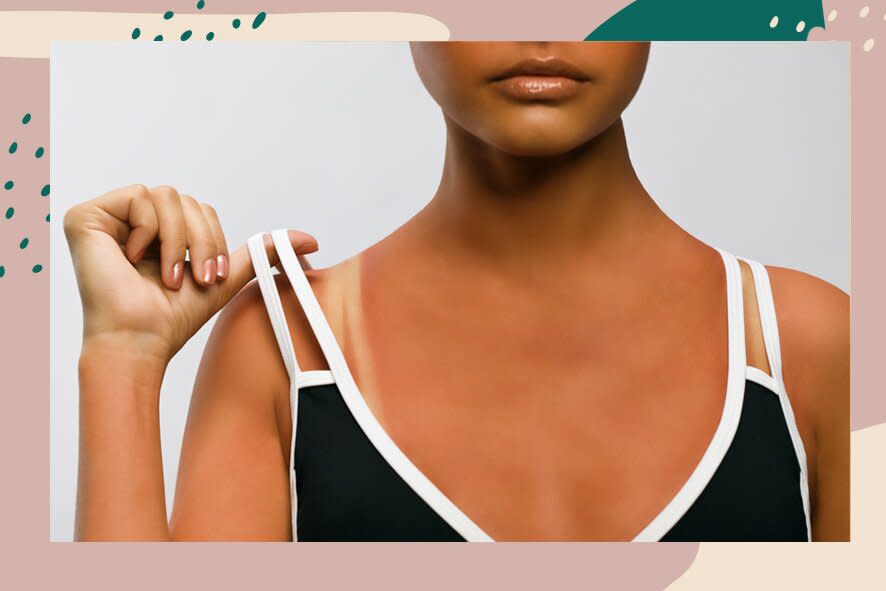Sun Damage Looks Different On Every Skin Tone—Here's What Experts Say You Should Look For

Getty Images
In case you needed a reminder, sunlight can wreak some serious havoc on your skin if you aren't protected by SPF. Long-term ultraviolet radiation from the sun can cause early signs of aging, breakdown of collagen, hyperpigmentation, broken blood vessels, and most dangerously, it can cause certain types of skin cancers. However, sun damage can look different depending on your specific skin tone.
According to the Skin Cancer Foundation, your skin tone is one of the most important factors in determining your sun damage risk. To break it down, the organization uses a scientific classification known as the Fitzpatrick skin types, which groups skin tones into six overarching categories that range from light to dark. To better understand how sun damage manifests on each skin tone, we tapped several dermatologists to ask them what visible signs to look for and when people should seek a professional for care.
Sun damage on fair skin tones:
Since people with Fitzpatrick skin types one and two are very fair, they have a very high risk of developing sunburn, sun damage, and certain skin cancers. Board-certified dermatologist Suzanne Friedler, M.D. explains that people with fair skin are more predisposed to sun damage since they have less skin pigmentation (melanin) to filter out the UV rays. This, she says, makes fair skin more susceptible to sun damage and skin cancers such as basal cell carcinoma, squamous cell carcinoma, and melanoma.
Board-certified dermatologist Nava Greenfield, M.D. notes that sun damage usually appears as brown, red, and white spots on the arms, legs, chest, and light brown spots or red small vessels on the face. Freckles might also appear as a sign of damage. Adds Dr. Friedler, "Wrinkling tends to be more pronounced in those with fair skin, making it important to be especially diligent with sun protection."

Sun damage on medium skin tones:
Medium-toned individuals, or Fitzpatrick skin types three and four, have the ability to tan quicker and burn less than fairer skin types. Board-certified dermatologist Purvisha Patel, M.D., says that they are still at risk for sun damage, though. According to a 2013 study published in Advances in Dermatology and Allergology, people with medium skin tones have bigger melanocytes—aka skin cells that maintain melanin production.
“Because this skin tone has bigger melanocytes [than fairer types], they can develop sun spots and freckles easily,” Dr. Patel says. “Wounds and scars also get darker when exposed to the sun.” But despite having more melanin than fairer tones, Dr. Patel stresses the importance of remembering that medium-toned individuals are still at risk in developing skin cancers. She explains that these skin types tend to stay out longer in the sun since they don't burn as easily and that this cumulative prolonged exposure can lead to skin cancers.

Sun damage on dark skin tones:
Those with darker complexions tend to develop fewer wrinkles than lighter skin types and are less likely to develop skin cancer. However, Dr. Friedler says it's still possible for them to experience sun damage. Plus, the Skin Cancer Foundation reports that just one to two percent of skin cancer diagnoses are from POC, but those cases are typically diagnosed in the later stages, meaning they're more dangerous.
"The redness may be harder to see on dark skin, but darker skin tones are more prone to pigmentary changes such as melasma," she explains. "Wrinkles look similar in all skin types, but it takes longer to produce the photo-damage in darker skin tones." Dr. Greenfield says sun spots may also show up as light marks on deeper skin.
Additionally, people with dark skin are more prone to acral lentiginous melanoma, a form of cancer more common in melanin-rich skin. Dark spots may appear on the palms of your hands, soles of your feet, and underneath your nails, so be sure to check these areas.

BlackCAT, Getty Images
Be cautious—you may mistake a sunburn for other concerning health conditions.
While sun damage can look different for each skin tone, Susan Chon, M.D. says there are times when you may be mistaking sun damage for something more serious. "If a lesion is tender, painful, or not healing, you should go to your dermatologist immediately," Dr. Chon says. "You'll want to rule out if that lesion is actually cancerous."
She also urges people to look closely at their freckles (or sunspots), especially if it changes significantly. If it becomes asymmetrical, the border becomes irregular, becomes multicolored, increases in diameter, or has any significant change in how it appears or how it feels, Dr. Chon says you should see a dermatologist immediately to get a professional diagnosis.
Lastly, you may assume that a rash formed on your skin after a long day in the sun is a sunburn, but it could also be an allergic reaction to the sun's UV rays. A 2018 article published by Harvard Medical School revealed that sun allergies are an immune system response to sunlight, and it's characterized by a rash, tiny blisters, or some other type of skin eruption. If you get a mild case of sun allergy, you may just have to stay out of the sun for a few days, but more severe cases may require prescription treatments.
Moral of the story? It doesn't matter what your skin tone is—everyone should apply sunscreen every single day to avoid potential sun damage and keep your skin happy and healthy.

